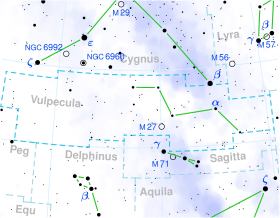13 Vulpeculae is a blue giant with a stellar classification of class B9.5III[4] in the northern constellation Vulpecula. It is visible to the naked eye as a faint, blue-white hued star with an apparent visual magnitude of 4.57[4] and it is approximately 339 light years away from the Sun based on parallax. The star is radiating 180[4] times the luminosity of the Sun from its photosphere at an effective temperature of 8,801 K.[8]
Quick facts Observation data Epoch J2000 Equinox J2000, Apparent magnitude (V) ...
13 Vulpeculae
Location of 13 Vulpeculae (circled) |
Observation data
Epoch J2000 Equinox J2000 |
| Constellation |
Vulpecula |
| 13 Vulpeculae A |
| Right ascension |
19h 53m 27.6957s[1] |
| Declination |
24° 04′ 46.608″[1] |
| Apparent magnitude (V) |
4.584±0.008[2] |
| 13 Vulpeculae B |
| Right ascension |
19h 53m 27.6102s[3] |
| Declination |
24° 04′ 46.077″[3] |
| Characteristics |
| Spectral type |
B9.5III[4] |
| Apparent magnitude (U) |
4.404±0.012[2] |
| Apparent magnitude (B) |
4.536±0.010[2] |
| Astrometry |
|---|
| 13 Vulpeculae A |
|---|
| Radial velocity (Rv) | −28.10[5] km/s |
| Proper motion (μ) | RA: 22.325±0.065[1] mas/yr
Dec.: 36.510±0.072[1] mas/yr |
| Parallax (π) | 9.6342±0.0902 mas[1] |
| Distance | 339 ± 3 ly
(103.8 ± 1.0 pc) |
| Absolute magnitude (MV) | −0.48[4] |
| 13 Vulpeculae B |
|---|
| Proper motion (μ) | RA: 14.037±0.135[3] mas/yr
Dec.: 32.954±0.131[3] mas/yr |
| Parallax (π) | 9.8828±0.1524 mas[3] |
| Distance | 330 ± 5 ly
(101 ± 2 pc) |
| Orbit[6] |
|---|
| Period (P) | 615.25±104.12 yr |
| Semi-major axis (a) | 1.555±0.241″ |
| Eccentricity (e) | 0.079±0.042 |
| Inclination (i) | 85.9±1.5° |
| Longitude of the node (Ω) | 68.1±0.3° |
| Periastron epoch (T) | 2027.82±94.79 |
Argument of periastron (ω)
(secondary) | 169.7±4.4° |
| Details |
|---|
| 13 Vul A |
|---|
| Radius | 1.3[7] R☉ |
| Luminosity | 180[4] L☉ |
| Temperature | 8,801[8] K |
| Metallicity [Fe/H] | −0.11[4] dex |
| Rotational velocity (v sin i) | 45.0[9] km/s |
|
|---|
| Other designations |
|---|
| 13 Vul, BD+23°3820, GC 27544, HD 188260, HIP 97886, HR 7592, SAO 87883, CCDM J19535+2405AB, WDS J19535+2405AB, 2MASS J19532768+2404464[10] |
| Database references |
|---|
| SIMBAD | data |
Close
There is one reported companion, designated component B, with a magnitude of 7.37, an orbital period of roughly 615 years, and an angular separation of 1.55″.[11] The system is moving closer to the Earth with a heliocentric radial velocity of −28 km/s.[5]

